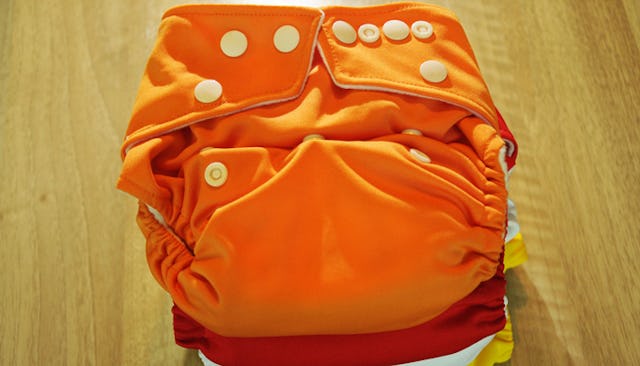The Gross Reality Of Cloth Diapers

Last night, I spent a whopping 20 minutes dunking cloth diapers in the toilet to clean off the solid leftovers of the bougie baby food that two days ago my wee lad made a grand show of protesting. Pretty gross, huh?
During pregnancy with baby number two, my husband and I swore the solemn cloth diaper oath. We got the 17,000 diaper inserts. We got the 13,000 designer cloth covers. We even got a bidet attachment for the toilet. We bought the special cloth diaper laundry detergent to go with the ridiculously overpriced cloth diaper pail that came in colors like Dusty Sahara Rose and Ecru. We settled on Robin’s Egg Blue. Learning that we could not use regular butt paste with cloth diapers, we purchased organic balms and coconut oil.
Not having any idea how to use cloth diapers, we read hours of reviews and tutorials online, which included some hilariously confusing YouTube videos. Whenever we met up with our parent friends, we would grill them for tips and advice. We were heavily invested in this kid’s derrière.
During my nesting phase of pregnancy, I washed those suckers repeatedly and line-dried them in the hot summer sun. One wash might have been enough, but somewhere I read that the more I washed them the more absorbent they became. And by golly, that stash of cloth diapers had better absorb. I neatly folded each one and lovingly piled them up in the baby’s rapidly expanding changing area. Forget the changing table, this kid was going to need his own bathroom.
When babies are brand-spanking new they are pretty much biological blobs of love. When they poop, it is actually kind of cute and funny. Parents love to talk about baby poop. You think I’m kidding? Ask me about my oldest son’s first month of life, and chances are you’ll get at least four poop stories. When babies progress into roughly month six or seven, they begin to eat solid foods. Sure they don’t eat much, but they eat enough so that those delightfully charming and expensive diapers are now disgusting poop traps for the business end of a growing kid.
Fast-forward to last night. My son has been increasing his solid food intake, which is great. Although, since he is exclusively breastfed, this whole solid foods thing is a tricky new adventure. He is reluctant to give up the boob. I am reluctant to clean up his diapers. But we push on into the exhilarating world of gastronomy.
He filled two diapers, one right after the other. The thing about breastfed babies is that it is common for them to not have a bowel movement for a few days in a row. For this lucky housewife, it had been three beautiful poop-free days of diaper bliss.
So there I was in the bathroom with two cloth diapers filled with poop. Step one was to open them up and remove the inserts. Gross. Step two was to scrape the solid mass off the cloth lining. Grosser. Step three should have been to soak them before tossing them into the wash. But oh, no, no. This was no ordinary mess. This required scrubbing. Being the mom, it fell to me to figure this one out. The bidet we special ordered did not have the spray power to tackle this job. So on went the pink rubber gloves as I plunged my hands and cloth diapers into the toilet to scrap off my dignity.
After my tactical bathroom challenge, I tossed the offending diapers in the wash and set the washer to heavy-duty soak. There really ought to be a setting called “Just this Side of Obliterate.” Then I put my feet up and took a deep breath of clean air.
As a quick side note, I should just say, thank God for aunts. My marvelous aunt was online last night, and she shared some entertaining poop stories about my babyhood. It made me feel the humor of this disgusting situation. She also kindly—and in a roundabout way—reminded me of why we wanted to have cloth diapers in the first place. They may be gross and a serious pain in the derrière to take care of, but they are good for a baby’s skin and good for the environment. Besides, they make for some pretty darn funny stories.
This article was originally published on